The Story
1942 - ATLANTIC OCEAN:
- - - - - -
- - - - - -
MAY 1942 IN THE PACIFIC
- - - - - -
IN EUROPE
- - - - - -
IN AFRICA
- - - - - -
IN ASIA
- - - - - -
IN AMERICA

- - - - - -
- 18 May - At around 20:30 in the evening, hunting between West Africa and South America the Italian Submarine R. Smg. Comandante Cappellini, surfaced and fired its torpedoes, deck gun and machine guns upon the unescorted and unarmed Swedish Cargo Ship M/S Tisnaren. Tisnaren sank the next morning, 19 May.

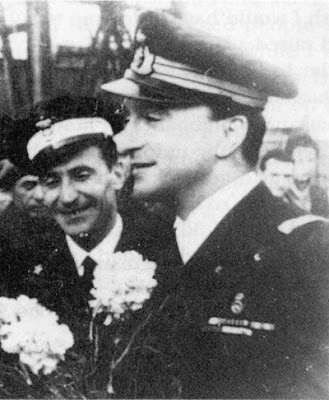
Captain Gunnar Runsten (left), and Submarine Commander Marco Revedin with his Second-in-Command Federico de Siervo.

World War II Poster of a torpedoed Tanker M/S Tisnaren was commanded by Captain Gunnar Runsten, my grandfather and these pages are based on his written statment of the attack, and a collection of public information on the Net.
- ...on that same day, in waters closer to the West Indies:
- 18 May 02:10 A.M. The Beth was hit by two torpedoes from Kptlt. Jürgen Wattenberg's U-162 and sank. 21 men, including the master reached Barbados in two lifeboats after 36 hours, nine others landed at Tobago in a third lifeboat on 20 May.
- 18 May 06:06 A.M. The unescorted and unarmed Mercury Sun was hit by two torpedoes from Kptlt. Ulrich Folkers's U-125 about 125 miles south of Cape Corrientes, Cuba, while steaming a zigzag course at 8.5 knots. The torpedoes struck on the port side at the #4 and #5 tanks and broke the back of the ship. The carbon dioxide smothering system on the tanker successfully kept the cargo from igniting after the first torpedo hit, but when the second hit the ship burst into flames. 29 of the nine officers and 26 crewmen managed to abandon ship in two lifeboats. At 06:35, a coup de grâce struck the vessel on the starboard side at #8 tank, but the ship remained afloat and sank about three hours after the first attack, sagging in the middle. The master, chief mate, second mate and three crewmembers were lost. The lifeboats stayed near the burning ship until daybreak and then sailed towards the coast. 28 survivors were picked up nearly 40 hours after the attack by the American steam merchant Howard and landed on 19 May at Mobile, Alabama. One seriously injured crewman was transferred to a US Coast Guard boat at the Tampa Sea Buoy.
- 18 May 06:15 A.M. The unescorted Fauna was hit by one stern torpedo from Kptlt. Günther Krech's U-558 and sank after 17 minutes. The U-boat misidentified her victim as the Towa. The survivors landed on Providence Island the same day.
- 18 May 10:18 A.M. The unescorted and unarmed Quaker City was hit by one torpedo from KrvKpt. Werner Hartenstein's U-156 about 300 miles east of Barbados. The torpedo struck in the stern near the waterline and caused the ship to sink in ten minutes. The explosion shattered the propeller, the rudder and the after part of the ship and killed ten crewmen. The surviving ten officers and 20 crewmen immediately abandoned ship in four lifeboats and were questioned by the Germans. They were given the course to Barbados before the U-boat left the area. On 22 May, seven survivors in one boat were picked up by USS Blakeley at 15°01N/57°38W and landed at Trinidad two days later. On 24 May, the 15 survivors in the boat of the master landed at Barbados and eight survivors in another boat made landfall on the north coast of Dominica on 26 May. An oiler later died ashore from injuries.
- 18 May 06:52 P.M. The unescorted San Eliseo was hit on the starboard side under the bridge and amidships by two torpedoes also from KrvKpt. Werner Hartenstein's U-156. The tanker had been spotted five hours before and continued after counter-flooding, firing into the direction of the U-boat, which surfaced and tried to get into a new firing position. At 04:39 on 19 May, a third torpedo was fired that hit on the starboard side aft of the bridge but apparently only caused minor damage because the tanker still continued. Even a fourth torpedo hit at 07:39 on the starboard side near the engine room could not stop her. At 09:17, a stern torpedo was fired at the ship from the port side but missed because the tanker zigzagged wild from 120° to 330°. The U-boat had finally to give up the chase because it was ordered by the BdU to set course on Martinique immediately and the chance to score another hit on the alarmed tanker was very small. The San Eliseo arrived at Barbados on 20 May for temporary repairs, later continued to the USA where she returned to service after permanent repairs were made.
- 18 May (time unknown) S/S William J Salman also sunk by Folkers's U-125 at 20.08N, 83.46W. Three more unarmed US merchant vessels are sunk by German submarines. A freighter east of Barbados by KrvKpt. Werner Hartenstein's U-156 while Kptlt. Ulrich Folkers's U-125 sinks a tanker and a freighter in the Gulf of Mexico.
- 4 May The Battle of the Coral Sea begins: it will last four days and is a first in that the ships on both sides never are in sight of the other; the USS Lexington is sunk, but the Americans can claim an overall victory.
- 8 May The Battle of the Coral Sea comes to an end. This is the first time in naval history where two enemy fleets fought without seeing each other. In addition to the loss of the USS Lexington the USS Yorktown is badly damaged; it returns to Pearl Harbour for repairs.
- 27 May The USS Yorktown, damaged at the Coral Sea, limps into Pearl Harbor; it is ordered to get repaired and ready as fast as possible for the impending battle.
- 30 May The USS Yorktown leaves Pearl after hasty repairs and moves to join the USS Enterprise for the next expected battle.
- 31 May An attack on Sydney Harbour, Australia - Japanese midget submarines infiltrate the Harbour in an attempt to attack Allied warships.
- 5 May The city of Exeter is bombed by the Luftwaffe, another "Baedeker Raid".
- 8 May The Germans take the Kerch peninsula in the eastern Crimea, Russia.
- 12 May Second Battle of Kharkov - In the eastern Ukraine, the Soviet Army initiates a major offensive. During the battle the Soviets will capture the city of Kharkov from the German Army, only to be encircled and destroyed.
- 18 May The Russians are in a major retreat at Kerch, after large numbers surrender.
- 21 May The German invasion plans for Malta is postponed indefinitely.
- 22 May The battle of Kharkov continues; for the Germans it is an important step on the way to Stalingrad.
- 27 May Reinhard Heydrich, head of Reich Security, is fatally hurt in Prague by bomb and gunfire in the "Operation Anthropoid" ambush by Czech patriots; he will die on 4 June from his wounds.
- 30 May "The Thousand Bomber Raid" on Köln (Cologne), revealing new area bombing techniques.
- 31 May Huge German successes around Kharkov, with envelopment of several Russian armies.
- 1 May Rommel readies for a new offensive during the early part of this month.
- 5 May British forces begin "Operation Ironclad": the invasion of Madagascar to keep the Vichy French territory from falling to a possible Japanese invasion.
- 26 May Rommel begins a Spring offensive at the Gazala line (west of Tobruk). The battle lasts well into June and ends with a total victory for Rommel.
- 27 May British use American Sherman tanks in attempts to stop Rommel's attacks on the Gazala line.
- 29 May Rommel turns his troops to Bir Hachim on the south edge of the Gazala line; once it is taken, he can move north and destroy the Allied emplacements in the line.
- 1 May Japanese take Mandalay and other ports in Burma.
- 3 May The Japanese forces land on Tulagi Island in the Solomons, not far from Guadalcanal.
- 5 May Heavy Japanese artillery attack on Corregidor in the Philippines.
- 6 May On Corregidor, the last U.S. forces in the Philippines surrender to the Japanese. About 12,000 are made prisoners.
- 20 May The Japanese conquest of Burma is complete; it is called a "military catastrophe."
- 29 May Japanese forces have large successes south of Shanghai, China.
- 11 May The very first allied ship on the St. Lawrence River, Canada is sunk by a U-boat.
- 21 May Mexico declares war against Nazi Germany and the Axis after the sinking of the Mexican tanker Faja de Oro by Kptlt. Georg Lassen's U-160, off Key West.
- 25 May In preparation for the next battle, Japanese naval strategists send diversionary forces to the Aleutians in the Alaskan Peninsula, the very extreme point of the United States.

- - - - - -


 HMS Esperance Bay (F-67) - Armed Merchant Cruiser
HMS Esperance Bay (F-67) - Armed Merchant Cruiser  HMS Deptford (L-53 / U-53) - Sloop, Grimsby class
HMS Deptford (L-53 / U-53) - Sloop, Grimsby class  HMS Delhi (D-47) - Light cruiser, D class
HMS Delhi (D-47) - Light cruiser, D class

 HMS Viscount (D-92) - Destroyer, Admiralty V & W class
HMS Viscount (D-92) - Destroyer, Admiralty V & W class
 HMS Gleaner (J-83) - Minesweeper, Halcyon class
HMS Gleaner (J-83) - Minesweeper, Halcyon class HMS Bluebell (K-80) - Corvette, Flower class (*)
HMS Bluebell (K-80) - Corvette, Flower class (*)  HMS Clarkia (K-88) - Corvette, Flower class
HMS Clarkia (K-88) - Corvette, Flower class HMS Maloja (F-26) - Armed Merchant Cruiser - former RMS Maloja of the Peninsular & Oriental Steam Navigation Co Ltd. (*) HMS Bluebell (Lt. Geoffrey Herbert Walker, DSC, RNVR) was later torpedoed and sunk by Kptlt. Hans-Günther Lange's U-711 on 17 Feb 1945 off the Kola Inlet, Russia. On 4 May 1945 U-711 was sunk during the Royal Navy Fleet Air Arm Operation "Judgement", which was actually aimed at the depot ships Black Watch and Senja lying at Kilbotn, south of Harstad, Norway. Bombs from Avenger aircrafts, operating off HMS Trumpeter and HMS Queen, destroyed her, leaving 40 dead and 12 survivors. She sank after attempts by Kptlt. Hans-Günther Lange and ten other crew members to separate her from the Black Watch and to keep her afloat. The rest of the crew had already gone on board the Black Watch and were killed as she went down. Only a few hours earlier the captain had received the signal from Germany ordering all U-boats to cease attacks on allied shipping.
HMS Maloja (F-26) - Armed Merchant Cruiser - former RMS Maloja of the Peninsular & Oriental Steam Navigation Co Ltd. (*) HMS Bluebell (Lt. Geoffrey Herbert Walker, DSC, RNVR) was later torpedoed and sunk by Kptlt. Hans-Günther Lange's U-711 on 17 Feb 1945 off the Kola Inlet, Russia. On 4 May 1945 U-711 was sunk during the Royal Navy Fleet Air Arm Operation "Judgement", which was actually aimed at the depot ships Black Watch and Senja lying at Kilbotn, south of Harstad, Norway. Bombs from Avenger aircrafts, operating off HMS Trumpeter and HMS Queen, destroyed her, leaving 40 dead and 12 survivors. She sank after attempts by Kptlt. Hans-Günther Lange and ten other crew members to separate her from the Black Watch and to keep her afloat. The rest of the crew had already gone on board the Black Watch and were killed as she went down. Only a few hours earlier the captain had received the signal from Germany ordering all U-boats to cease attacks on allied shipping. 
 HMS Skate (H-39) - Destroyer, Admiralty R class
HMS Skate (H-39) - Destroyer, Admiralty R class HMS Calendula (K-28) - Corvette, Flower class
HMS Calendula (K-28) - Corvette, Flower class HMS Wellington (L-65 / U-65) - Sloop, Grimsby class
HMS Wellington (L-65 / U-65) - Sloop, Grimsby class

 HMS Wild Swan (D-62) - Destroyer, Admiralty Modified W class *
HMS Wild Swan (D-62) - Destroyer, Admiralty Modified W class * 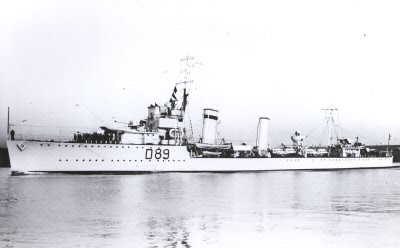
 HMS Witch (D-89) - Destroyer, Admiralty Modified W class
HMS Witch (D-89) - Destroyer, Admiralty Modified W class 
 HMS Campanula (K-18) - Corvette, Flower class
HMS Campanula (K-18) - Corvette, Flower class 
 HMS Bridgewater (L-01 / U-01) - Sloop, Bridgewater class
HMS Bridgewater (L-01 / U-01) - Sloop, Bridgewater class  HMS Aberdeen (L-97 / U-97) - Sloop, Grimsby class HMS Periwinkle (K-55) - Corvette, Flower class HMS Gardenia (K-99) - Corvette, Flower class ** HMS Fleur de Lys (K-122) - Corvette, Flower class *** HMS Spaniard (FY-144) - Anti-Submarine Trawler **** HMS Bengali (FY-165) - Anti-Submarine Trawler **** HMS Cavina (F-33) - Ocean Boarding vessel - former S/S Cavina, a Banana Freighter for the Elders & Fyffes Co * HMS Wild Swan (Lt.Cdr. Claude Edward Lutley Sclater, RN) was later sunk by Luftwaffe on 17 Jun 1942 south of Ireland. ** HMS Gardenia was sunk off Oran, Algeria on 9 Nov 1942 in a collision with the minesweeping trawler HMS Fluellen. *** HMS Fleur de Lys (Lt. Alexander Collins, RNR) was later torpedoed and sunk on 14 Oct 1941 by Kptlt. Herbert Opitz's U-206 about 55 nautical miles west of Gibraltar. There were only three survivors. **** HMS Spaniard and HMS Bengali was later both sunk by an explosion at Lagos, Nigeria on 5 Dec 1942. More Naval history for 22 Dec:
HMS Aberdeen (L-97 / U-97) - Sloop, Grimsby class HMS Periwinkle (K-55) - Corvette, Flower class HMS Gardenia (K-99) - Corvette, Flower class ** HMS Fleur de Lys (K-122) - Corvette, Flower class *** HMS Spaniard (FY-144) - Anti-Submarine Trawler **** HMS Bengali (FY-165) - Anti-Submarine Trawler **** HMS Cavina (F-33) - Ocean Boarding vessel - former S/S Cavina, a Banana Freighter for the Elders & Fyffes Co * HMS Wild Swan (Lt.Cdr. Claude Edward Lutley Sclater, RN) was later sunk by Luftwaffe on 17 Jun 1942 south of Ireland. ** HMS Gardenia was sunk off Oran, Algeria on 9 Nov 1942 in a collision with the minesweeping trawler HMS Fluellen. *** HMS Fleur de Lys (Lt. Alexander Collins, RNR) was later torpedoed and sunk on 14 Oct 1941 by Kptlt. Herbert Opitz's U-206 about 55 nautical miles west of Gibraltar. There were only three survivors. **** HMS Spaniard and HMS Bengali was later both sunk by an explosion at Lagos, Nigeria on 5 Dec 1942. More Naval history for 22 Dec: 

 HMS Walker (D-27) - Destroyer, Admiralty V & W Class
HMS Walker (D-27) - Destroyer, Admiralty V & W Class 
 HMS Volunteer (D-71) - Destroyer, Admiralty Modified W class
HMS Volunteer (D-71) - Destroyer, Admiralty Modified W class  HMS Vanoc (H-33) - Destroyer, Admiralty V & W Class
HMS Vanoc (H-33) - Destroyer, Admiralty V & W Class 
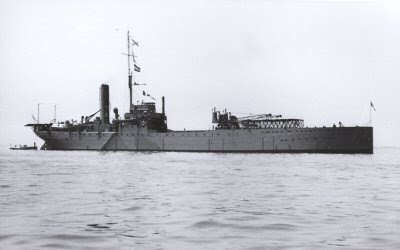
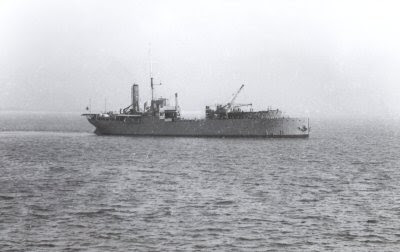 HMS Pegasus - Fighter Catapult Armed Merchant ship (CAM), Pegasus class HMS Caldwell (I-20) - Destroyer, Town Class HMS Fleetwood (L-47 / U-47) - Sloop, Grimsby Class HMS Tulip (K-29) - Corvette, Flower Class More Naval history for 27 Feb:
HMS Pegasus - Fighter Catapult Armed Merchant ship (CAM), Pegasus class HMS Caldwell (I-20) - Destroyer, Town Class HMS Fleetwood (L-47 / U-47) - Sloop, Grimsby Class HMS Tulip (K-29) - Corvette, Flower Class More Naval history for 27 Feb:  HMS Malcolm (D-19) - Destroyer, Admiralty Leader class
HMS Malcolm (D-19) - Destroyer, Admiralty Leader class 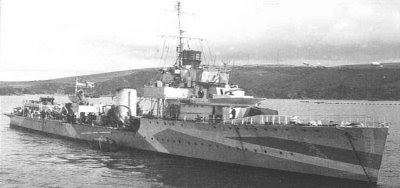
 HMS Watchman (D-26) - Destroyer, Admiralty V & W class
HMS Watchman (D-26) - Destroyer, Admiralty V & W class  HMS Wolfe (F-37) - Armed Merchant Cruiser & Submarine Depot Ship
HMS Wolfe (F-37) - Armed Merchant Cruiser & Submarine Depot Ship  HMS Scimitar (H-21) - Destroyer, Admiralty S class
HMS Scimitar (H-21) - Destroyer, Admiralty S class  HMS Sardonyx (H-26) - Destroyer, Admiralty S class
HMS Sardonyx (H-26) - Destroyer, Admiralty S class  HMS Arabis (K-73) - Corvette, Flower class
HMS Arabis (K-73) - Corvette, Flower class 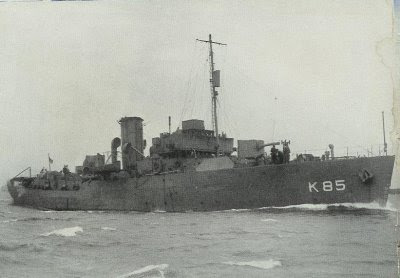 HMS Verbena (K-85) - Corvette, Flower class
HMS Verbena (K-85) - Corvette, Flower class  HMCS Annapolis (I-04) - Destroyer, Town class
HMCS Annapolis (I-04) - Destroyer, Town class  HMCS Niagara (I-57) - Destroyer, Town class
HMCS Niagara (I-57) - Destroyer, Town class 
 HMCS Levis (K-115) - Corvette, Flower class *
HMCS Levis (K-115) - Corvette, Flower class *  HMCS Napanee (K-118) - Corvette, Flower class
HMCS Napanee (K-118) - Corvette, Flower class  HMCS Agassiz (K-129) - Corvette, Flower class
HMCS Agassiz (K-129) - Corvette, Flower class 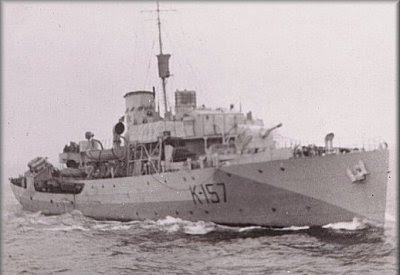
 HMCS Dauphin (K-157) - Corvette Flower class
HMCS Dauphin (K-157) - Corvette Flower class 
 HMCS Mayflower (K-191) - Corvette, Flower class HMS Burnham (H-82) - Destroyer, Town class HMS Violet (K-35) - Corvette, Flower class HMCS Galt (K-163) - Corvette, Flower class HMS Northern Pride (FY-105) - Anti-Submarine Trawler HMS Northern Wave (FY-153) - Anti-Submarine Trawler HMS Northern Gem (FY-194) - Anti-Submarine Trawler * HMCS Levis (Lt C.W. Gilding, RCNR) was later hit by one torpedo on 19 Sep 1941 from Kptlt. Eitel-Friedrich Kentrat's U-74 east of Cape Farewell while escorting the convoy SC.44 as part of the 19th Escort Group. The ship was taken in tow by HMCS Mayflower (Lt.Cdr. G.Stephen, RCNR), but foundered later that day. 18 crew members went down with the ship. 91 survivors were picked up by the corvette. More Naval history for 5 Aug:
HMCS Mayflower (K-191) - Corvette, Flower class HMS Burnham (H-82) - Destroyer, Town class HMS Violet (K-35) - Corvette, Flower class HMCS Galt (K-163) - Corvette, Flower class HMS Northern Pride (FY-105) - Anti-Submarine Trawler HMS Northern Wave (FY-153) - Anti-Submarine Trawler HMS Northern Gem (FY-194) - Anti-Submarine Trawler * HMCS Levis (Lt C.W. Gilding, RCNR) was later hit by one torpedo on 19 Sep 1941 from Kptlt. Eitel-Friedrich Kentrat's U-74 east of Cape Farewell while escorting the convoy SC.44 as part of the 19th Escort Group. The ship was taken in tow by HMCS Mayflower (Lt.Cdr. G.Stephen, RCNR), but foundered later that day. 18 crew members went down with the ship. 91 survivors were picked up by the corvette. More Naval history for 5 Aug:  HMS Vansittart (D-64) - Destroyer, Admiralty Modified W class
HMS Vansittart (D-64) - Destroyer, Admiralty Modified W class  HMS Starwort (K-20) - Corvette, Flower class
HMS Starwort (K-20) - Corvette, Flower class  HMS Cyclamen (K-83) - Corvette, Flower class
HMS Cyclamen (K-83) - Corvette, Flower class  HMS Armeria (K-187) - Corvette, Flower class
HMS Armeria (K-187) - Corvette, Flower class  HMS Aster (K-188) - Corvette, Flower class
HMS Aster (K-188) - Corvette, Flower class  HMS Sandwich (L-12 / U-12) - Sloop, Bridgewater class
HMS Sandwich (L-12 / U-12) - Sloop, Bridgewater class 
 HMS Scarborough (L-25 / U-25) - Sloop, Folkestone class
HMS Scarborough (L-25 / U-25) - Sloop, Folkestone class 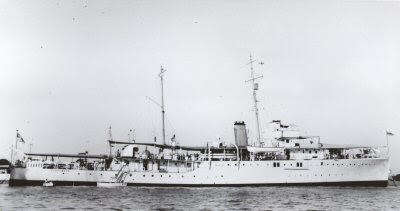
 HMS Fleetwood (L-47 / U-47) - Sloop, Grimsby class
HMS Fleetwood (L-47 / U-47) - Sloop, Grimsby class 
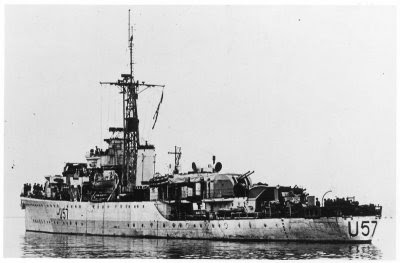 HMS Black Swan (L-57 / U-57) - Sloop, Black Swan class
HMS Black Swan (L-57 / U-57) - Sloop, Black Swan class  HMS Bachaquero (LST-110) - Landing Ship, Tank
HMS Bachaquero (LST-110) - Landing Ship, Tank 
 HMS Hilary (F-22) - Ocean Boarding vessel - former RMS Hilary III HMS Burra (T-158) - Mine Sweeper Trawler, Isles class More Naval history for 1 Oct:
HMS Hilary (F-22) - Ocean Boarding vessel - former RMS Hilary III HMS Burra (T-158) - Mine Sweeper Trawler, Isles class More Naval history for 1 Oct:  HMS Keppel (D-84) - Destroyer, Shakespeare class
HMS Keppel (D-84) - Destroyer, Shakespeare class  HMS Sabre (H-18) - Destroyer, Admiralty S class
HMS Sabre (H-18) - Destroyer, Admiralty S class  HMS Saladin (H-54) - Destroyer, Admiralty S class
HMS Saladin (H-54) - Destroyer, Admiralty S class  HMS Beverley (H-64) - Destroyer, Town class *
HMS Beverley (H-64) - Destroyer, Town class *  HMS Brilliant (H-84) - Destroyer, B class
HMS Brilliant (H-84) - Destroyer, B class  HMS Mallow (K-81) - Corvette, Flower class
HMS Mallow (K-81) - Corvette, Flower class 
 HMS Hastings (L-27 / U-27) - Sloop, Folkestone class
HMS Hastings (L-27 / U-27) - Sloop, Folkestone class 
 HMS Londonderry (L-76 / U-76) - Sloop, Grimsby class
HMS Londonderry (L-76 / U-76) - Sloop, Grimsby class  HMS Lulworth (Y-60) - Sloop, Banff class HMS Coreopsis (K-32) - Corvette, Flower class HMS Wallflower (K-44) - Corvette, Flower class HMS Wivern (D-66) - Destroyer, Admiralty Modified W class HMS Aubretia (K-96) - Corvette, Flower class HMS Burdock (K-126) - Corvette, Flower class HMS Coltsfoot (K-140) - Corvette, Flower class FNFL Commandant Detroyat (K-183) - Corvette, Flower class HMS Tamarisk (K-216) - Corvette, Flower class HMS Landguard (Y-56) - Sloop, Banff class Molde - Anti-Submarine Trawler - former Norwegian Whaler Kos XX * HMS Beverley (Lt.Cdr. Rodney Athelstan Price, RN) was later and sunk on 11 Apr 1943 by Kptlt. Siegfried Lüdden's U-188. There were only 4 survivors out of 155. More Naval history for 14 Mar:
HMS Lulworth (Y-60) - Sloop, Banff class HMS Coreopsis (K-32) - Corvette, Flower class HMS Wallflower (K-44) - Corvette, Flower class HMS Wivern (D-66) - Destroyer, Admiralty Modified W class HMS Aubretia (K-96) - Corvette, Flower class HMS Burdock (K-126) - Corvette, Flower class HMS Coltsfoot (K-140) - Corvette, Flower class FNFL Commandant Detroyat (K-183) - Corvette, Flower class HMS Tamarisk (K-216) - Corvette, Flower class HMS Landguard (Y-56) - Sloop, Banff class Molde - Anti-Submarine Trawler - former Norwegian Whaler Kos XX * HMS Beverley (Lt.Cdr. Rodney Athelstan Price, RN) was later and sunk on 11 Apr 1943 by Kptlt. Siegfried Lüdden's U-188. There were only 4 survivors out of 155. More Naval history for 14 Mar: 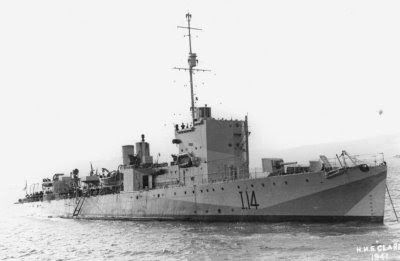 HMS Clare (I-14) - Destroyer, Town class
HMS Clare (I-14) - Destroyer, Town class  HMS Hydrangea (K-39) - Corvette, Flower class
HMS Hydrangea (K-39) - Corvette, Flower class 
 HMS Pelican (L-86 / U-86) - Sloop, Egret class
HMS Pelican (L-86 / U-86) - Sloop, Egret class  HMS Corinthian (F-103) - Ocean Boarding vessel - former Ellerman Lines S/S Corinthian
HMS Corinthian (F-103) - Ocean Boarding vessel - former Ellerman Lines S/S Corinthian 
 HMS Largs - Ocean Boarding vessel - former French fruit-carrier M/V Charles Plumier HMS Amaranthus (K-17) - Corvette, Flower class HMS Aubretia (K-96) - Corvette, Flower class HMS Tamarisk (K-216) - Corvette, Flower class HMS Deptford (L-53 / U-53) - Sloop, Grimsby class HMS Lowestoft (L-59 / U-59) - Sloop, Grimsby class More Naval history for 2 May:
HMS Largs - Ocean Boarding vessel - former French fruit-carrier M/V Charles Plumier HMS Amaranthus (K-17) - Corvette, Flower class HMS Aubretia (K-96) - Corvette, Flower class HMS Tamarisk (K-216) - Corvette, Flower class HMS Deptford (L-53 / U-53) - Sloop, Grimsby class HMS Lowestoft (L-59 / U-59) - Sloop, Grimsby class More Naval history for 2 May: